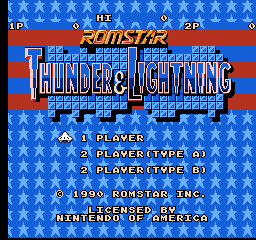Thunder & Lightning (NES)
| Thunder & Lightning |
|---|
|
Also known as: Family Block (JP)
|
Just another one of those Breakout-type games, this time with co-op multiplayer!
Unused Graphics
![]()
![]()
Frames of the pyramid block cracking rather than dividing when hit as it does in the final.
![]()
A mahjong tile, which may have been intended as a type of obstacle.
![]()
A rounded block. May also be a mahjong tile (white dragon), since it is stored underneath the previous one.
![]()
Two frames for what appears to be a bubble.
![]()
A piece of glass or ice, another possible obstacle.
![]()
An egg-block, stored next to the turtle-shell blocks used in stage 3, 13, and 23.

What may have been an unused background pattern. The graphics are set up in order of appearance in the ROM.
Unused Music
The round/lives display screen has music, whose beginning is very similar to the title screen music, but you never get to hear the full song. If you did, you'd notice that it doesn't actually have the same melody, and that it's slightly different from the title screen music. Use the Game Genie code ZAKATAPA to listen to the full song at the title screen instead of the original melody.
There are some unused sound effects as well. Tracks 1, 5, 8, $B, $C, $D, $13, $14, $16, $17 in the SE pointer table are unused (the actual in-game index is $0A higher).
Ending
There is a total of 30 valid levels in both the US and Japanese versions of the game. Upon completing level 30, the game unceremoniously ends with a GAME OVER screen - kind of a slap in the face, considering how difficult the game is. For some reason, the Japanese version continues on to level 31, 32, etc. afterwards, which are nothing but garbage; the US version at least fixes this oversight.
- Pages missing developer references
- Games developed by Visco
- Pages missing publisher references
- Games published by Romstar
- Games published by Athena
- NES games
- Pages missing date references
- Games released in 1990
- Games released in December
- Games with unused graphics
- Games with unused music
- Games with regional differences
Cleanup > Pages missing date references
Cleanup > Pages missing developer references
Cleanup > Pages missing publisher references
Games > Games by content > Games with regional differences
Games > Games by content > Games with unused graphics
Games > Games by content > Games with unused music
Games > Games by developer > Games developed by Visco
Games > Games by platform
Games > Games by publisher > Games published by Athena
Games > Games by publisher > Games published by Romstar
Games > Games by release date > Games released in 1990
Games > Games by release date > Games released in December
The Cutting Room Floor > Unimportant Awards > NES games

